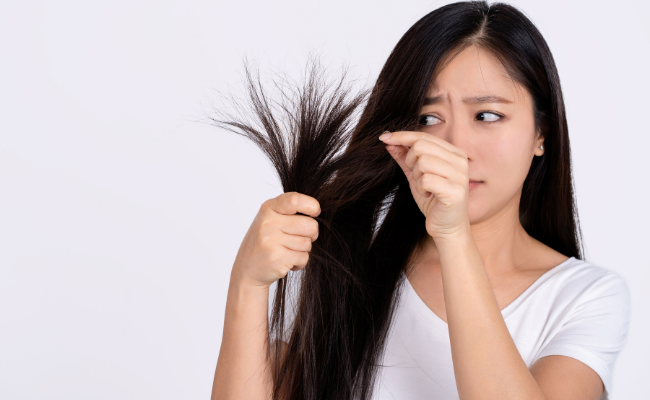How to Treat Hair Damage?
- October 28, 2023
- No Comments

What is Hair Damage?
Hair damage is a prevalent concern resulting from diverse factors, spanning environmental stressors, chemical treatments, and inadequate hair care practices. Its manifestations include dryness, split ends, breakage, and a lackluster appearance. Recognizing the indications of damaged hair is pivotal for implementing effective treatment strategies.
The occurrence of hair breakage can be ascribed to various factors. The foundation of healthy hair relies on an internal cuticle with overlapping scales that furnish structural cohesion to your strands. When these scales are disrupted, your hair tends to become dry and prone to separation, ultimately leading to damage. This disruption presents as breakage and is often accompanied by symptoms such as frizz and dryness.
Why is Treating Hair Damage Important?
Addressing hair damage is essential for maintaining healthy and vibrant hair. Unresolved damage can lead to further complications, including increased breakage, loss of elasticity, and a compromised overall appearance. Beyond the aesthetic aspects, healthy hair is more manageable and less prone to additional damage, contributing to overall well-being and confidence.
How to Treat Hair Damage?
- Trimming: Regular trims are a fundamental aspect of treating hair damage. Trimming helps eliminate split ends and prevents further breakage. By removing damaged portions, the hair is encouraged to grow healthier.
- Moisturizing: Hydration plays a pivotal role in treating dry and damaged hair. Opt for a moisturizing shampoo and conditioner to replenish lost moisture. Additionally, consider incorporating a deep conditioning treatment or hair mask into your routine for an extra boost of hydration.
- Gentle Washing: Overwashing can strip away natural oils, contributing to dryness. Use a sulfate-free shampoo to retain essential oils that protect and nourish your hair. Washing less frequently can also contribute to healthier hair.
- Heat Styling Caution: Limit the use of heat styling tools such as flat irons and curling irons. When heat styling is necessary, apply a heat protectant spray to minimize damage and protect the hair shaft from excessive heat.
- Protective Styles: Embracing protective styles can minimize manipulation and reduce exposure to environmental elements. Styles like braids, buns, and twists provide a protective barrier, preventing damage and promoting healthier hair.
- Balanced Diet: Nutrition is a critical factor in hair health. Ensure your diet includes a balance of vitamins, minerals, and proteins, which are essential for supporting strong and healthy hair growth.
Treatment Solutions for Hair Damage:
- Protein Treatments: Protein treatments help strengthen the hair shaft, reducing breakage. Look for products containing keratin or other protein-rich ingredients to restore the structural integrity of the hair.
- Hot Oil Treatments: Hot oil treatments are effective in providing deep conditioning and restoring moisture to dry and damaged hair. Coconut oil, argan oil, and olive oil are popular choices for hot oil treatments.
- Scalp Massages: Regular scalp massages stimulate blood flow to the hair follicles, promoting a healthy scalp environment and encouraging hair growth. This simple practice can contribute to overall hair health.
- Avoiding Harsh Chemicals: Minimizing the use of harsh chemicals, such as excessive hair dyes and bleach, is crucial to preventing further damage. Opt for gentler, ammonia-free products if you need to color your hair.
- Silk or Satin Pillowcases: Switching to silk or satin pillowcases can benefit damaged hair. These materials create less friction, reducing the risk of breakage and split ends while you sleep.
Benefits of Treating Hair Damage:
- Prevention of Further Damage: The primary benefit of treating damaged hair is the prevention of further issues such as breakage and split ends. This proactive approach safeguards the overall health of your hair.
- Improved Manageability: Healthy hair is more manageable, requiring less effort in styling. Reduced frizz and smoother texture contribute to easier styling without the need for excessive heat or chemical treatments.
- Enhanced Appearance: Well-maintained hair looks shinier, smoother, and more vibrant. The enhanced appearance goes beyond aesthetics, reflecting the overall health of the hair.
- Boosted Confidence: The positive impact on self-esteem and confidence is a notable benefit of treating hair damage. Healthy and well-groomed hair can positively influence how an individual feels about themselves.
- Long-Term Hair Health: Implementing effective treatment strategies contributes to the long-term health of your hair. By addressing damage and adopting healthy practices, you promote resilience and prevent future damage, ensuring the ongoing vitality of your hair.
Comments (0)